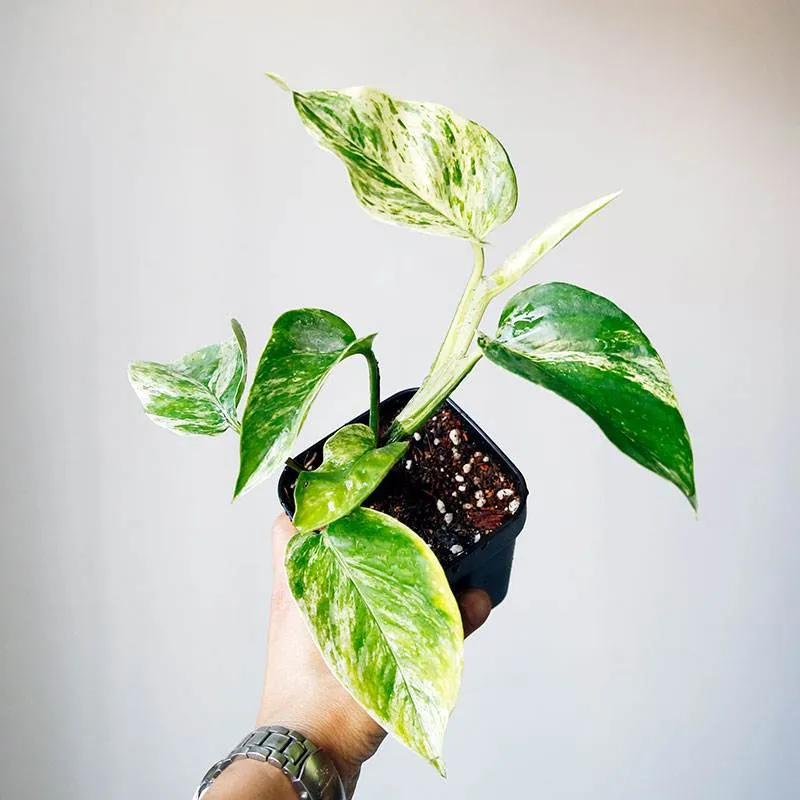How To Grow And Care For Manjula Pothos
Written by Ivy
Jan 20 2023
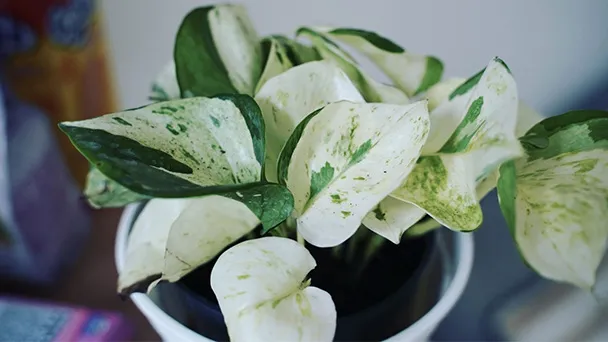
How to grow and care for Manjula Pothos? Manjula Pothos is the best choice for beginners. Manjula Pothos can grow in an environment that other indoor plants cannot adapt to. Through a process similar to photosynthesis, manjula Pothos can decompose toxic substances released from fabrics, walls and smoke into plant owned substances. Manjula Pothos's beautiful leaves have unique decoration. Especially when manjula Pothos hangs outside the hanging basin, such plants are easy to take care of, It can grow well even in a dark environment.
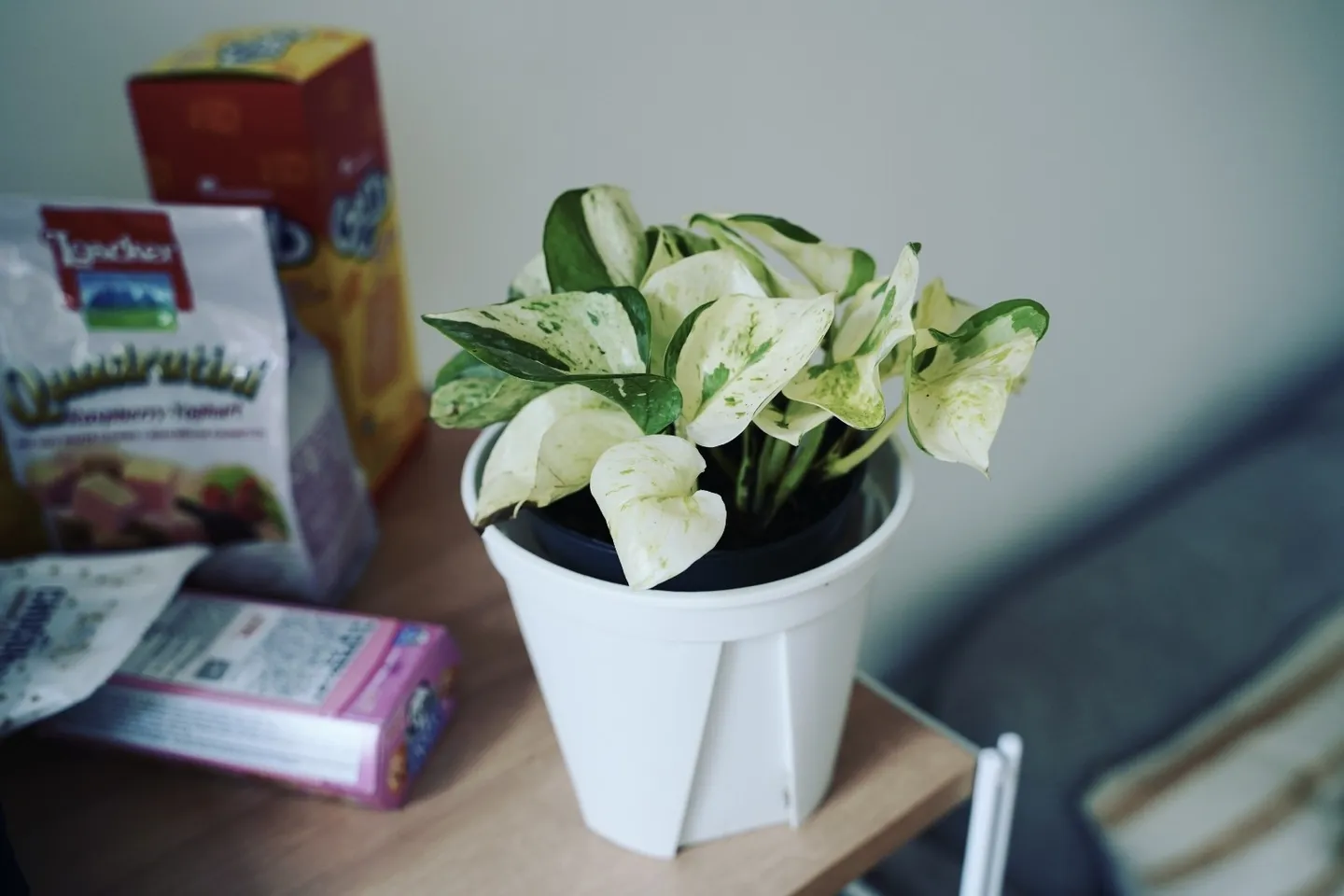
Read More: How To Fix Overwatered Pothos
Moreover, inhibiting the growth of some branches of manjula Pothos will also promote the growth of new branches of manjula Pothos in its basin soil. In this way, the fuller the plant type of manjula Pothos will be. When it reaches its satisfaction, it can stop pruning and let its branches grow to their strengths.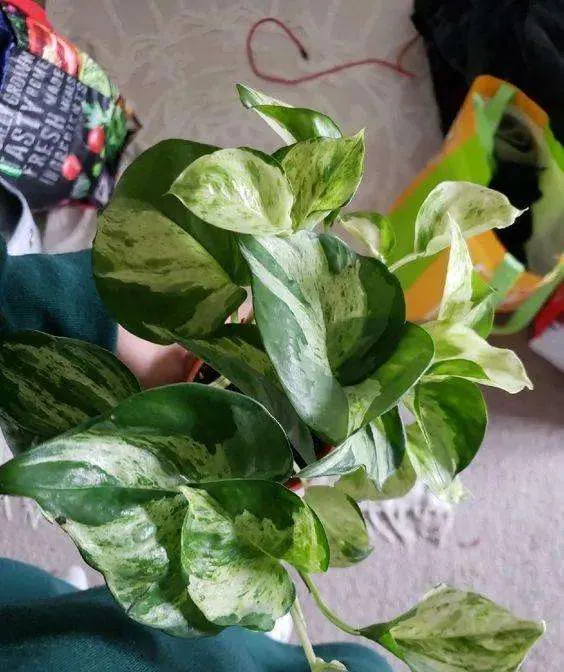
Manjula Pothos needs to be treated before basin change. Firstly, manjula Pothos needs to be dug out from the soil. After cleaning its roots with clean water, you can use sharp scissors to cut off the overdense roots of manjula Pothos, so as to help the plant save nutrients. After pruning, you need to apply carbendazim solution to the wound to help the wound heal as soon as possible.
When changing pots, manjula Pothos can be directly planted in the prepared pot soil, and then water the soil with mineral rich river or lake water to keep the soil moist. In order to make manjula Pothos grow healthily, carbendazim solution can also be sprayed on the plant to eliminate bacteria in the environment.
Control Method: We should wash manjula Pothos leaves with clean water and usually bask in the sun. Drug spraying, anthrax infection can only be controlled by drugs. Anthrax infection can only be controlled by drugs. We can choose carbendazim, tobuzin or carbendazim to dilute and spray the solution once every 1 ~ 2 days and once every 3 ~ 4 times.
Control Method: We should remove diseased leaves in time, pay attention to ventilation and provide sufficient sunshine. Spray agent, spray Daphne ammonium solution 500 times, and spray control.
Control Method: Spray 50% carbendazim at the onset, or directly irrigate the root. When manjula Pothos is seriously ill, we can directly change the soil, pull out the green pineapple, remove the rotten part of the root and replant.
Read More: Pothos Root Rot - Cause And Treatment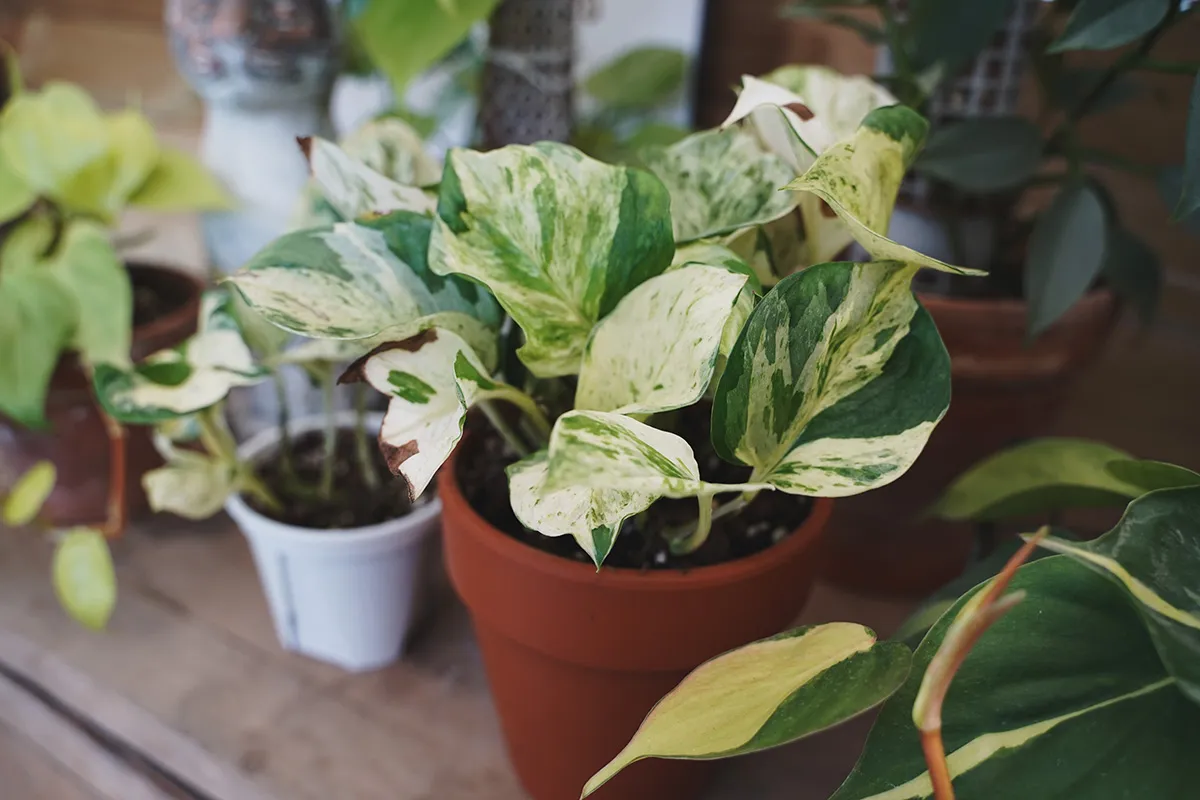
The cuttings of manjula Pothos are best carried with a section and a leaf, or the whole section can be selected to enrich the branch cuttings. Starting from the end of the stem node, the upper part of the leaf is cut off for each inserted node. In the early stage of cutting, we should keep the soil moist. We should pay attention to moisturizing and place manjula Pothos in the semi shade to promote rooting and germination. When new buds begin to germinate from leaf axils, a small amount of slow-release fertilizer can be applied to promote the growth of new branches.
We can gently disassemble the roots of manjula Pothos. During this period, we found that all rotten, blackened and shriveled roots should be cut off. If there are too many old roots, we should also cut them properly, and only about 8cm roots should be reserved so that manjula Pothos can sprout new roots.
For the manipulated manjula Pothos, we should soak the root system in the diluted carbendazim solution for disinfection. If there is no carbendazim, we can use potassium permanganate or purple medicine. Generally, we can take it out and dry it after soaking for 15 minutes.
After the roots of manjula Pothos are air dried, we can prepare fertile peat soil, form 3-4 treated green roses into a cluster, re plant them into new soil, pour water and place them in a cool and ventilated place for slow basin.
Read More:
Manjula Pothos Quick InfoManjula Pothos Care in DetailManjula Pothos WateringManjula Pothos SoilManjula Pothos LightManjula Pothos TemperatureManjula Pothos HumidityManjula Pothos FertilizerManjula Pothos PruningManjula Pothos RepottingManjula Pothos Pest & Disease ControlManjula Pothos PropagationManjula Pothos Propagation from CuttingManjula Pothos Propagation from Division
Manjula Pothos Quick Info
| Botanical/Scientific Name | Epipremnum Aureum Manjula |
| Common Name | Manjula Pothos, Happy Leaf Pothos, HANSOTI14 |
| When to Grow/Bloom/Harvest | Grow in Spring and Summer |
| Uses | Indoor plants, indoor hanging plants |
| Origin | India |
| Light Care | Medium to bright light |
| Soil Care | Moist soil but not soggy or wet |
| Temperature Care | 60 to 80 °F (16-27 °C) |
| Humidity Care | High humidity |
| Watering | Water every two to three weeks |
| Pruning Care | Regular pruning |
| Fertilizer Care | Houseplant fertilizer |
| Propagation | Stem Cuttings |
| Toxic | Toxic to humans, cats |
Manjula Pothos Care in Detail

Manjula Pothos Watering
Manjula Pothos has a high demand for water. Generally, it is appropriate to keep the basin soil moist. Remember that we can't use rice washing water. Although rice washing water has many nutrients that can be used, it must be used after retting, fermentation and ripening, otherwise it will not only easily produce insects, but also lead to rotten roots in serious cases. If the temperature is high in summer, manjula pothos grows vigorously and has a large water storage capacity, it needs to be watered once in about 2 days. In autumn and winter, the amount of watering should be controlled according to the indoor temperature. When the room temperature is lower than 10 ℃, the soil evaporation of the plant is slow. Watering should be reduced. Watering should be done once every 4 ~ 5 days. Watering should not be too frequent after heating. Watering should be done once every 3 ~ 4 days.Read More: How To Fix Overwatered Pothos
Manjula Pothos Soil
Manjula Pothos has a high demand for soil drainage. We can properly mix some compost into the soil to increase fertility. Manjula Pothos does not have a high demand for fertilizer. Generally, it is only necessary to supplement organic thin fertilizer once a month in spring and summer. (Read More: How to Choose The Best Pot For a Pothos Plant)Manjula Pothos Light
Manjula Pothos is suitable for growing in a relatively warm environment, so we also need to provide appropriate light for the plant when growing Manjula Pothos, so that the plant can grow more vigorously. In addition, when the light is too strong, we need to shade the plant in time to avoid burning the plant by too strong light, resulting in the failure of normal growth of manjula Pothos.Manjula Pothos Temperature
The suitable temperature for the growth of manjula Pothos is 16 ~ 27 ℃. During caring, the room temperature should not exceed this range too much. Too high temperature will cause excessive growth of branches and leaves, too low temperature, slow growth and prone to frostbite. Generally, we can put manjula Pothos in a place with sufficient indoor light. Do not let the sun shine directly or completely block the sun, which will lead to yellowing of leaves.Manjula Pothos Humidity
Manjula Pothos has a great demand for humidity during its growth. Therefore, when maintaining manjula Pothos, it is necessary to provide an appropriate amount of water for the plant, wet all the soil, provide a relatively humid growth environment for manjula Pothos, and when watering manjula Pothos, it is best to directly pour the water into the soil to keep the soil moist.Manjula Pothos Fertilizer
Manjula Pothos has little demand for fertilizer and is very resistant to concentrated fertilizer. Therefore, we must control the fertilizer concentration before applying fertilizer to manjula Pothos. If it is granular fertilizer, do not use too much. Bury it around the basin soil and keep it away from the root to avoid injury. If it is liquid fertilizer, we must dilute it with water before watering it to the root of manjula Pothos. And when watering, pay attention not to sprinkle fertilizer on branches and leaves, so as not to be unfavorable to their growth. (Read More: Why Are My Pothos Leaves Curling)Manjula Pothos Pruning
When taking care of manjula Pothos, we should not rush to make the branches long, but trim them appropriately. When the branches of manjula Pothos grow to about 30 cm, directly trim the top, so that manjula Pothos will grow side branches. When the side branches grow to more than 20 cm, trim the top, so that it will continue to grow side branches.Moreover, inhibiting the growth of some branches of manjula Pothos will also promote the growth of new branches of manjula Pothos in its basin soil. In this way, the fuller the plant type of manjula Pothos will be. When it reaches its satisfaction, it can stop pruning and let its branches grow to their strengths.

Manjula Pothos Repotting
We need to select the appropriate basin soil when changing the basin for manjula Pothos. The selected flowerpot needs to have good air permeability, and the caliber needs to be larger than that of manjula Pothos plant. The selected soil needs to meet the plant growth needs. Lvluo is suitable for growing in fertile and loose soil. Therefore, sandy loam with rich organic matter and good drainage can be selected for planting soil.Manjula Pothos needs to be treated before basin change. Firstly, manjula Pothos needs to be dug out from the soil. After cleaning its roots with clean water, you can use sharp scissors to cut off the overdense roots of manjula Pothos, so as to help the plant save nutrients. After pruning, you need to apply carbendazim solution to the wound to help the wound heal as soon as possible.
When changing pots, manjula Pothos can be directly planted in the prepared pot soil, and then water the soil with mineral rich river or lake water to keep the soil moist. In order to make manjula Pothos grow healthily, carbendazim solution can also be sprayed on the plant to eliminate bacteria in the environment.
Manjula Pothos Pest & Disease Control
- Anthrax
Control Method: We should wash manjula Pothos leaves with clean water and usually bask in the sun. Drug spraying, anthrax infection can only be controlled by drugs. Anthrax infection can only be controlled by drugs. We can choose carbendazim, tobuzin or carbendazim to dilute and spray the solution once every 1 ~ 2 days and once every 3 ~ 4 times.
- Leaf spot
Control Method: We should remove diseased leaves in time, pay attention to ventilation and provide sufficient sunshine. Spray agent, spray Daphne ammonium solution 500 times, and spray control.
- Root rot
Control Method: Spray 50% carbendazim at the onset, or directly irrigate the root. When manjula Pothos is seriously ill, we can directly change the soil, pull out the green pineapple, remove the rotten part of the root and replant.
Read More: Pothos Root Rot - Cause And Treatment
Manjula Pothos Propagation

Manjula Pothos Propagation from Cutting
When cutting manjula Pothos, we can choose top bud cutting or twig cutting. The disadvantage of these cuttings is that they are easy to produce adventitious roots and have strong regeneration ability. We can also obtain a large number of cuttings by single node cutting.The cuttings of manjula Pothos are best carried with a section and a leaf, or the whole section can be selected to enrich the branch cuttings. Starting from the end of the stem node, the upper part of the leaf is cut off for each inserted node. In the early stage of cutting, we should keep the soil moist. We should pay attention to moisturizing and place manjula Pothos in the semi shade to promote rooting and germination. When new buds begin to germinate from leaf axils, a small amount of slow-release fertilizer can be applied to promote the growth of new branches.
Manjula Pothos Propagation from Division
Manjula Pothos had better cut off water for 2-3 days before branching. We can dry the soil a little, and it will be easier to take off the pot. Then, take out the roots of manjula Pothos from the flower pot and pick up the soil attached to the roots by hand.We can gently disassemble the roots of manjula Pothos. During this period, we found that all rotten, blackened and shriveled roots should be cut off. If there are too many old roots, we should also cut them properly, and only about 8cm roots should be reserved so that manjula Pothos can sprout new roots.
For the manipulated manjula Pothos, we should soak the root system in the diluted carbendazim solution for disinfection. If there is no carbendazim, we can use potassium permanganate or purple medicine. Generally, we can take it out and dry it after soaking for 15 minutes.
After the roots of manjula Pothos are air dried, we can prepare fertile peat soil, form 3-4 treated green roses into a cluster, re plant them into new soil, pour water and place them in a cool and ventilated place for slow basin.
Read More:
- Why Are My Pothos Leaves Turning Yellow
- Pothos Root Rot - Cause And Treatment
- How To Fix Overwatered Pothos
- Snow Queen Pothos VS Marble Queen Pothos
- How To Grow And Care For Manjula Pothos
- Hawaiian Pothos VS Golden Pothos
- Epipremnum Aureum (Golden Pothos) Grow and Care
- How to Grow and Care for Scindapsus Pictus
- Cebu Blue Pothos Care & Propagation
- Glacier Pothos Care & Propagation Guide
- Silver Satin Pothos Care & Propagation
- Pearls and Jade Pothos Care & Propagation
- Neon Pothos Plant Care Guide
Latest Updated
- Benefits of Bugleweed - 7 Science-backed Health Benefits
- Bugleweed Dangers & Side Effects - Is It Poisonous?
- How to Plant Evergreen Trees - What You Should Know
- When to Plant Evergreens - Grow Guide for Evergreen Trees
- 12 Wonderful Evergreen Shrubs for Your Garden
- 12 Popular Evergreen Plants with Pictures for Beginners
- When And How To Prune A Lilac Bush Like a Pro
- How to Grow & Care for Lilac Vine (Hardenbergia Violacea)
- Japanese Lilac Tree (Syringa Reticulata) Care & Propagation Guide
- Shumard Oak Pros and Cons - What to Know
Popular Articles
- Winter maintenance of Antirrhinum Majus
- How to Grow Terminalia Mantaly Tree
- How to Grow and Care for Crossostephium Chinense
- How to grow Antirrhinum Majus in spring
- Peristeria Elata (Dove Orchid) Profile: Info & Care Guide
- Underwatered Snake Plant (Sansevieria Trifasciata) - Signs And How To Fix
- How to Care for Brazilian Jasmine Plant (Mandevilla Sanderi)
- How to Grow & Care for Graptopetalum Purple Delight in Summer
- Rosa Chinensis (China Rose): Plant Growing & Care Tips
- How to Care for Baby Sun Rose (Aptenia Cordifolia)
